
A hammer is a tool, most often a hand tool, consisting of a weighted "head" fixed to a long handle that is swung to deliver an impact to a small area of an object. This can be, for example, to drive nails into wood, to shape metal, or to crush rock. Hammers are used for a wide range of driving, shaping, breaking and non-destructive striking applications. Traditional disciplines include carpentry, blacksmithing, warfare, and percussive musicianship.
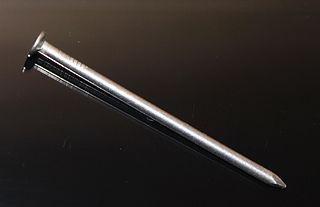
In woodworking and construction, a nail is a small object made of metal which is used as a fastener, as a peg to hang something, or sometimes as a decoration. Generally, nails have a sharp point on one end and a flattened head on the other, but headless nails are available. Nails are made in a great variety of forms for specialized purposes. The most common is a wire nail. Other types of nails include pins, tacks, brads, spikes, and cleats.

A zipper, zip, fly, or zip fastener, formerly known as a clasp locker, is a commonly used device for binding together two edges of fabric or other flexible material. Used in clothing, luggage and other bags, camping gear, and many other items, zippers come in a wide range of sizes, shapes, and colors. In 1892, Whitcomb L. Judson, an American inventor from Chicago, patented the original design from which the modern device evolved.

A stapler is a mechanical device that joins pages of paper or similar material by driving a thin metal staple through the sheets and folding the ends. Staplers are widely used in government, business, offices, work places, homes and schools.

A rivet is a permanent mechanical fastener. Before being installed, a rivet consists of a smooth cylindrical shaft with a head on one end. The end opposite the head is called the tail. On installation, the deformed end is called the shop head or buck-tail.

A staple gun or powered stapler is a hand-held machine used to drive heavy metal staples into wood, plastic, or masonry. Staple guns are used for many different applications and to affix a variety of materials, including insulation, house wrap, roofing, wiring, carpeting, upholstery, and hobby and craft materials. These devices are also known as trigger tackers.

A fastener or fastening is a hardware device that mechanically joins or affixes two or more objects together. In general, fasteners are used to create non-permanent joints; that is, joints that can be removed or dismantled without damaging the joining components. Steel fasteners are usually made of stainless steel, carbon steel, or alloy steel.

A treenail, also trenail, trennel, or trunnel, is a wooden peg, pin, or dowel used to fasten pieces of wood together, especially in timber frames, covered bridges, wooden shipbuilding and boat building. It is driven into a hole bored through two pieces of structural wood.

A staple remover is a device that allows for the quick removal of a staple from a material without causing damage. The best-known form of staple remover, designed for light-gauge staples, consists of two opposing, pivot-mounted pairs of thin, steep wedges and a spring that returns the device to the open position after use. Although a simple metal wedge can be used for the same purpose, and although some staplers feature such a wedge at their hinge end, use of the wedge tends to tear fragile papers.

A nail gun, nailgun or nailer is a form of hammer used to drive nails into wood or other materials. It is usually driven by compressed air (pneumatic), electromagnetism, highly flammable gases such as butane or propane, or, for powder-actuated tools, a small explosive charge. Nail guns have in many ways replaced hammers as tools of choice among builders.

A brass fastener, butterfly clips, brad, paper fastener or split pin is a stationery item used for securing multiple sheets of paper together. A patent of the fastener was issued in 1866 to George W McGill. The fastener is inserted into punched holes in the stack of paper, and the leaves, or tines, of the legs are separated and bent over to secure the paper. This holds the pin in place and the sheets of paper together. For few sheets of paper, holes can be made using the sharp end of the fastener.
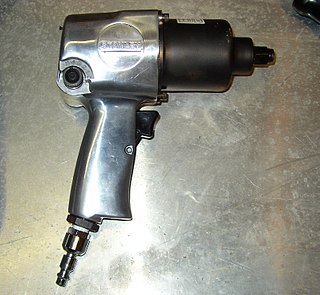
An impact wrench is a socket wrench power tool designed to deliver high torque output with minimal exertion by the user, by storing energy in a rotating mass, then delivering it suddenly to the output shaft. It was invented by Robert H. Pott of Evansville, Indiana.
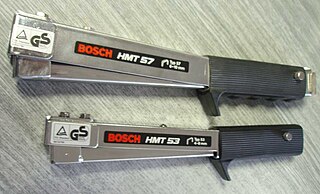
A Hammer stapler is a tool used for securing a variety of thin plastic and paper sheet building materials against flat surfaces by tacking a staple using a high velocity slapping motion similar to that of swinging a hammer. Typically the shallower the staple, the better hold its grip on the surface is.

Adhesive tape is one of many varieties of backing materials coated with an adhesive. Several types of adhesives can be used.

A screw gun is similar to a power drill, but designed specifically for driving screws. A screw gun looks like a drill, but has a "nose" instead of a chuck. The nose holds an interchangeable 1⁄4-inch (6.4 mm) shank bit, commonly known as a tip. The most common types of tips are 1 inch (25 mm) No. 2 Phillips, T25 Torx, and flatheads. The nose on either type of screw gun can be adjusted to countersink screws to the desired depth. The user must apply pressure to the bit to engage the clutch and drive the screws.
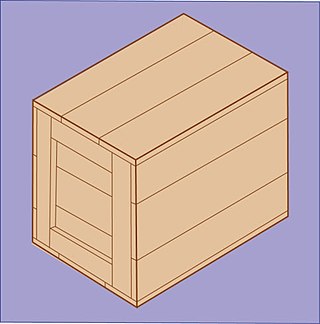
A wooden box is a container made of wood for storage or as a shipping container.
Morris Abrams (1908–1981) was the founder of Arrow Fastener Co., Inc., a manufacturer of fastening tools that has been a subsidiary of Hangzhou GreatStar Industrial since 2017.
Stanley Bostitch, previously and more commonly known as simply Bostitch, is an American company that specializes in the design and manufacture of fastening tools—such as staplers, staple guns, nailers, riveters, and glue guns—and fasteners—such as nails, screws, and staples. Its product range covers home, office, like the pencil sharpener, construction and industrial uses, like the power tool.

A rail fastening system is a means of fixing rails to railroad ties or sleepers. The terms rail anchors, tie plates, chairs and track fasteners are used to refer to parts or all of a rail fastening system. The components of a rail fastening system may also be known collectively as other track material, or OTM for short. Various types of fastening have been used over the years.
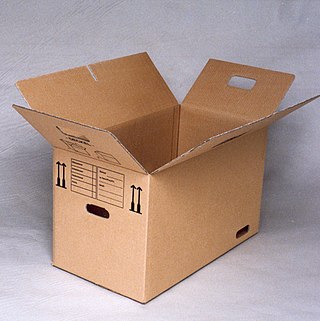
Corrugated box design is the process of matching design factors for corrugated fiberboard or corrugated plastic boxes with the functional physical, processing and end-use requirements. Packaging engineers work to meet the performance requirements of a box while controlling total costs throughout the system. Corrugated boxes are shipping containers used for transport packaging and have important functional and economic considerations.































